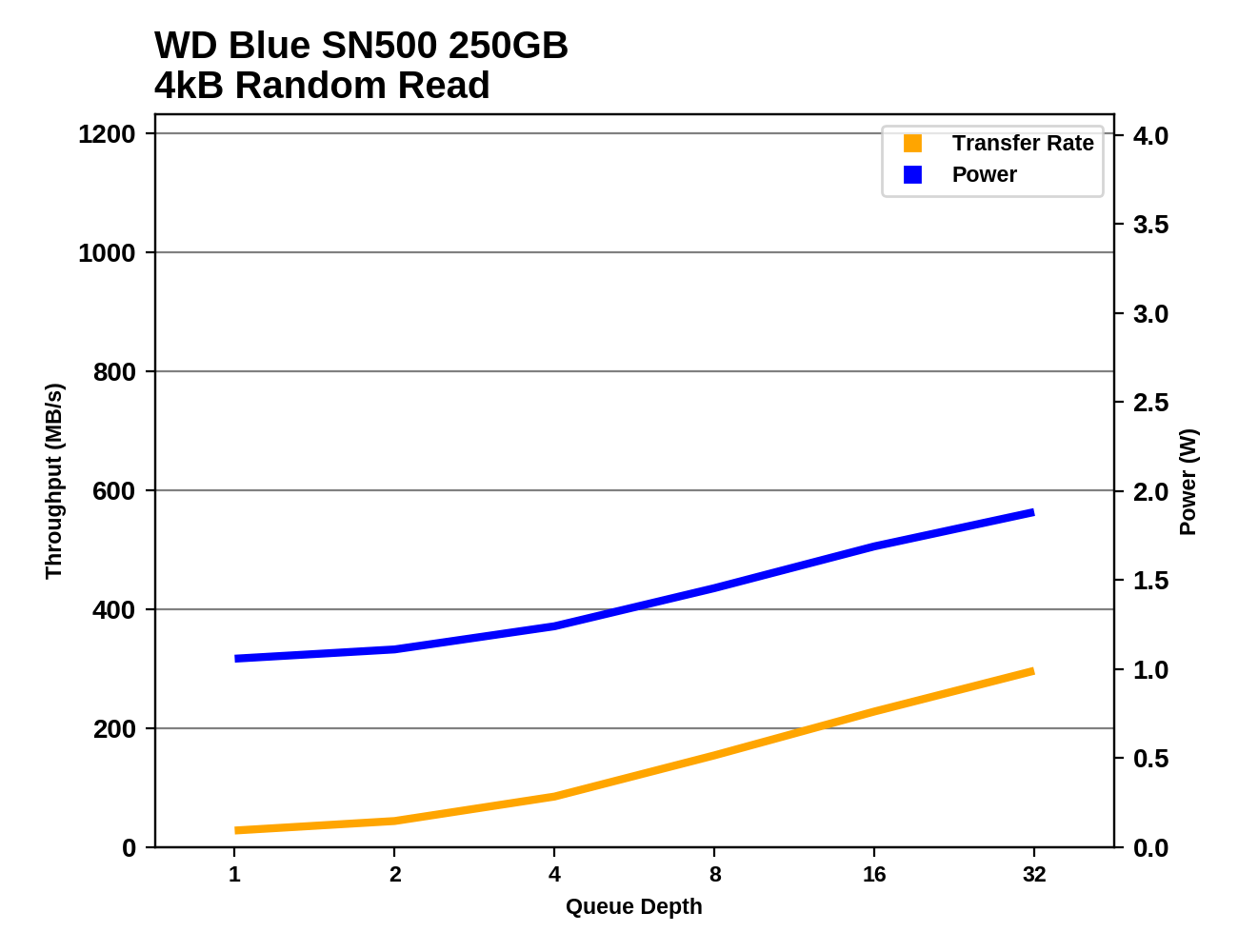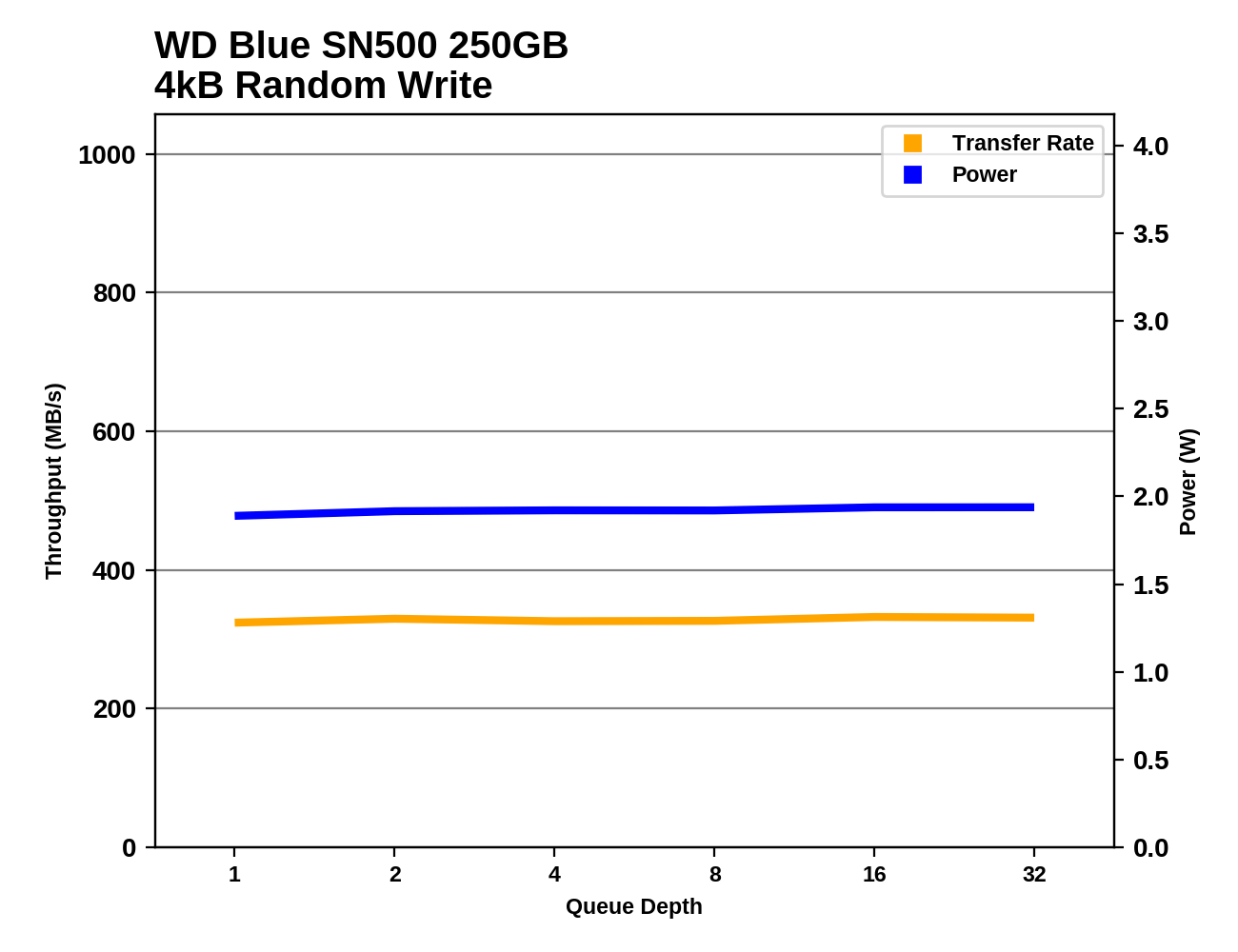The Western Digital WD Blue SN500 SSD Review: Moving The Mainstream To NVMe
by Billy Tallis on April 19, 2019 9:30 AM ESTRandom Read Performance
Our first test of random read performance uses very short bursts of operations issued one at a time with no queuing. The drives are given enough idle time between bursts to yield an overall duty cycle of 20%, so thermal throttling is impossible. Each burst consists of a total of 32MB of 4kB random reads, from a 16GB span of the disk. The total data read is 1GB.

This test is confined to a 16GB portion of the drive, but the WD Blue SN500 requires more spatial locality than that to offer its best random read performance, due to its DRAMless design with only a small on-controller buffer and no HMB support. The SN500 ends up as the worst-performing NVMe drive in the bunch and only beats the Toshiba TR200 DRAMless SATA SSD.
Our sustained random read performance is similar to the random read test from our 2015 test suite: queue depths from 1 to 32 are tested, and the average performance and power efficiency across QD1, QD2 and QD4 are reported as the primary scores. Each queue depth is tested for one minute or 32GB of data transferred, whichever is shorter. After each queue depth is tested, the drive is given up to one minute to cool off so that the higher queue depths are unlikely to be affected by accumulated heat build-up. The individual read operations are again 4kB, and cover a 64GB span of the drive.

On the longer random read test, the SN500 still fares poorly, but now that the test span has widened to 64GB, the Toshiba RC100's host memory buffer is also not large enough, and the RC100 falls behind the SN500.
 |
|||||||||
| Power Efficiency in MB/s/W | Average Power in W | ||||||||
The WD Blue SN500 and Toshiba RC100 draw significantly less power than any of the other NVMe drives during the random read test, with a low-QD average of a bit over 1W. This translates to a good but not great efficiency score for the SN500: the larger drives with much better performance have considerably better efficiency, as does the Samsung 850 EVO that provided 60% better performance without drawing any more power.
 |
|||||||||
All of the 250GB-class SSDs have limited potential for performance increases at high queue depth compared to higher capacity drives, but the SN500's performance scaling is poor even within its capacity class. Power consumption starts around 1W at QD1 and stays below 2W even at QD32, while the high-end NVMe drives start out above 2W and climb from there.
The random read performance of the WD Blue SN500 never gets out of SATA SSD territory, but the power efficiency is pretty good for the performance it does provide, especially at the higher queue depths.
Random Write Performance
Our test of random write burst performance is structured similarly to the random read burst test, but each burst is only 4MB and the total test length is 128MB. The 4kB random write operations are distributed over a 16GB span of the drive, and the operations are issued one at a time with no queuing.

This burst random write test is short enough that it doesn't come close to filling even the WD Blue SN500's tiny SLC cache, so the great performance of that cache shows through with a score that's competitive against almost any other drive in this capacity class, and only 12% slower than the 1TB WD Black SN750.
As with the sustained random read test, our sustained 4kB random write test runs for up to one minute or 32GB per queue depth, covering a 64GB span of the drive and giving the drive up to 1 minute of idle time between queue depths to allow for write caches to be flushed and for the drive to cool down.

On the longer random write test, the SLC cache on the WD Blue SN500 runs out and its performance falls out of the top tier for 256GB-class drives, but it doesn't fall very far. The SN500 still clearly outperforms the other entry-level NVMe drives we have to compare against.
 |
|||||||||
| Power Efficiency in MB/s/W | Average Power in W | ||||||||
The power efficiency score for the SN500 during the random write test is a close second place among its capacity class, and is much better than the SATA drives or other entry-level NVMe drives.
 |
|||||||||
This random write test writes much more data than can fit in the SN500's SLC write cache, so there's no opportunity for performance to bounce around depending on how much cache space was free at the start of each phase of the test. Instead, the SN500's performance and power consumption are very consistent across the entire tested range of queue depths.
The WD Blue SN500's random write performance is pretty close to the limit of what SATA SSDs can achieve, and it gets there while drawing less power than most other drives, but it doesn't set any records.












50 Comments
View All Comments
kpb321 - Friday, April 19, 2019 - link
A lot of people don't need much space. I just upgraded my wife from a 128gb SSD to a 256gb SSD. The 128GB SSD was getting a little full because of pictures of our son and I was occasionally having to free up space for Windows update etc. We could have stuck with the 128gb and migrated her entire picture collection to the NAS or kept freeing up space when needed but a 256 SATA SSD is so cheap I figured why not upgrade. Her old 128gb got stuck in my in-law's computer to replace the old slow 500gb hd they had in the system. They are using less than half the space on that SSD so should be fine for a long time and if really needed I can always setup the 500gb hd as a secondary storage drive for them. The old days of 32/64gb SSD being barely adequate are passed. Windows + a decent selection of apps is fine on a 128gb SSD and 256gb gives even more head room.jabber - Saturday, April 20, 2019 - link
Been running my work laptop on a 64GB SSD for several years now. Some of us don't need to keep masses of data on a device that goes out and about. Sometimes carrying masses of data is a liability.RealBeast - Friday, April 19, 2019 - link
Don't know about mainstream, but no way that I would waste precious M.2 slots on some small slow drive like this one.Sure a .5-2TB, but not really a 660P for me (they should be on SATA ports at my house). I use those ports for fast drives.
beginner99 - Saturday, April 20, 2019 - link
In a laptop you might have a point but in a desktop? Put the OS on it and the most used apps like browser. If you don't game you are already set. For games you can use a hdd or a large cheap sata ssd as it doesn't really matter much what you use.stephenbrooks - Sunday, April 21, 2019 - link
If you have a lot of games you'll want both large capacity and fast access.But other than capacity, this "low end" NVMe drive looks great. It's clearly possible for them to do 1TB+ versions in the future too, in one way or another.
Korguz - Sunday, April 21, 2019 - link
fazalmajid you may not see it.. but others do.. for me.. i usually use a small drive for my C drive, aka windows drive, before it was 120, now.. as 120 gig drives have next to vanished, im using 250 gig drives, with other bigger drives for other things.. so when it come times for format, and install fresh.. instead of having to move and then redo a big drive.. all i have to deal with, is a small drive with little to no " i want to keep this so i need to move it to another drive " swapping...stephenbrooks - Sunday, April 21, 2019 - link
I found Windows wants to put "User" data and "Program Files" on the same primary drive, so it can grow in size and even end up containing data I want to keep, even if I try to separate the two.Korguz - Monday, April 22, 2019 - link
i check those 2 directories as part of the " i want to keep this so i need to move it to another drive " searching, and then moving... :-)tipoo - Friday, April 19, 2019 - link
I'd still be interested in seeing a T2 SSD (Apple) put through these paces. Usually they did great in sequential tests but not so much in 4k randoms, so I wonder how it would do on, say, Destroyer.kpb321 - Friday, April 19, 2019 - link
This drive did exceed my expectations for a x2 pci-e lanes with no Dram and no HBM but the pricing is going to be key. The SM2262 drives have gotten pretty inexpensive and don't leave a lot of room for a drive like this even as good as it may be for what it is. I just recently picked up the ADATA version of the HP EX920 @ $73 for the 480gb drive. That a x4 drive with dram on it and should beat this drive pretty consistently. Personally this drive would need to be down around $60 before I'd consider the price difference meaningful enough to consider this drive.